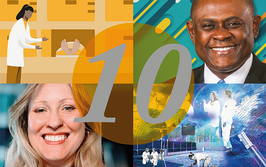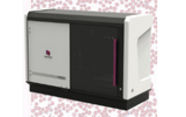
Diagnostic Demands: Part 1
We asked our 2024 Power Listers what’s missing from the diagnostic toolbox – and what they’re eagerly anticipating in the years to come
Jessica Allerton | | 4 min read | Discussion
Swikrity Upadhyay Baskota: Interactions with patients remain a key element of the field – yet they seem lost from the diagnostic toolbox. Diagnosis rendered by pathology teams guide management of patients, however, as pathologists we seldom get to interact with patients directly to discuss diagnosis, potential implications, and provide in-person support.
Akash Pramod Sali: In India, pathology training is largely limited to laboratory-related work. Many mentors at institutes “shed the clinician tag” and consider themselves part of support or ancillary services. The presence of Clinico-Pathological-Correlation (CPC) meetings and multidisciplinary team (MDT) meetings during training are largely restricted to larger institutes, and the net output at the end of the training is a “laboratory personnel”, not a “clinician”. I believe “clinical judgment” is certainly missing in diagnostic reports.
Kamran Mirza: A truly comprehensive, universally accessible digital pathology platform is still missing from our diagnostic toolbox. While there are several excellent platforms available, issues remain for interoperability between different systems and widespread adoption. A unified digital system that integrates AI, telepathology, and traditional diagnostics seamlessly would revolutionize the field – making it easier to share data, collaborate across institutions, and provide timely diagnosis regardless of geographical location.
Heather Keir: The comprehensive integration of multi-omics data can significantly enhance the diagnostic capabilities of pathologists, particularly in pediatric and perinatal pathology. By examining DNA, RNA, proteins, and metabolites, pathologists gain a more complete understanding of diseases, helping to identify genetic mutations, gene expression changes, and altered metabolic states. This detailed view is especially useful for diagnosing rare or complex pediatric conditions, including metabolic disorders common in neonates and infants.
Multi-omics analysis helps uncover molecular signatures of diseases, enabling personalized treatment plans tailored to a patient's genetic and molecular profile. It can also reveal biomarkers for disease progression and treatment response, aiding in better disease management.
This approach refines disease classification by identifying new subtypes based on molecular data rather than just clinical symptoms. It also opens the door for discovering new drug targets and innovative treatments. Overall, multi-omics integration enhances diagnostic precision, promotes personalized medicine, and fosters collaboration among medical specialists for optimized patient care.
Katalin Gocze: I believe pathology labs could improve their workflow by using technology more effectively. For example, combining multiple steps in the lab process could boost efficiency. While automation has helped with tracking and speed, pathology hasn't fully embraced available technology compared to fields like radiology, where digital tools for image sharing and remote consultations have been normalized. I’m hopeful pathology can catch up.
Norman Zerbe: Integrated multimodal computational diagnostic tools.
Tahir PIllay: We need a universally accessible, rapid, and cost-effective point-of-care diagnostic device that can perform comprehensive molecular and genetic testing. While advancements have been made, such devices are not yet widely available or affordable – especially in low-resource settings. This gap limits the ability to provide timely and accurate diagnoses in many parts of the world.
Sylvia Asa: Pathologists are not well prepared to convey their knowledge, wisdom and guidance to patients. Our toolbox currently does not include what is required to meet with a patient, provide them with the information we have about their situation, convey compassion, and offer guidance for navigating their treatment journey.
Rex F. Famitangco: There’s room for improvement in the development of non-invasive diagnostic techniques. A good example is liquid biopsies, which analyze biomarkers in fluids like urine, blood, or stool to detect diseases such as cancer. Improving the accuracy of these tests could provide important diagnostic information without needing invasive procedures like tissue biopsies.
Kinan Drak Alsibai: There is a need for more personalized medicine approaches in the diagnostic toolbox, tailored to individual patient characteristics.
Christina Zioga: A comprehensive and universally accessible database that integrates clinical, pathological, and genetic information is missing from the diagnostic toolbox. Such a resource would allow for more holistic and precise diagnoses by providing a complete picture of a patient's health. Additionally, we need more robust point-of-care diagnostic tools that can deliver rapid and accurate results in resource-limited settings.
Gamal Dawood: Pathology, although equipped with a powerful range of techniques, still has some gaps in its diagnostic toolbox. These include:
- Non-invasive detection tools: Early disease detection is crucial, but pathology often relies on invasive biopsies that aren’t practical for widespread screening. Non-invasive methods, like advanced imaging or blood tests, would improve the screening process.
- Standardization and quality control: Ensuring consistent results across labs and reducing variability between pathologists is an ongoing challenge. Standardized protocols and strong quality control are needed.
- Data integration: Pathologists handle various types of data, from microscope images to genetic information. Better tools to combine and analyze this data could ensure more accurate diagnoses.
- Predictive diagnostics: Pathology should not only diagnose but also predict disease risks. New tools are needed to identify patients at high risk for future conditions.
- Functional imaging: Combining traditional histopathology with techniques like molecular imaging or functional MRI could improve diagnostic accuracy and treatment decisions.
- Digital pathology and AI: While digital pathology gains traction, more development is needed in AI-driven tools to help pathologists analyze complex data and detect subtle patterns.
Addressing these gaps requires collaboration among researchers, clinicians, and industry partners. As technology continues to evolve, we can anticipate exciting developments that will fill these diagnostic voids in pathology.
Deputy Editor, The Pathologist




















